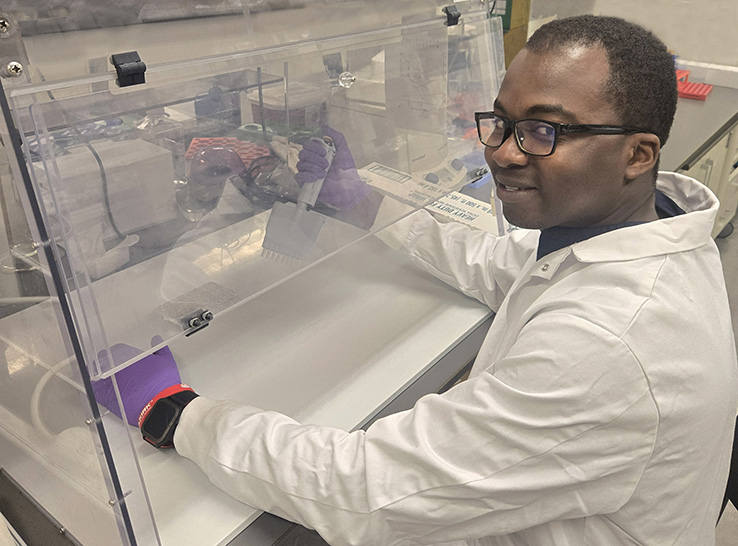A product using a blend of herbal extracts showed promising performance in reducing the effects of coccidiosis and histomoniasis, the poultry industry’s troublesome protozoal diseases.
Work led by Greg Mathis, PhD, Southern Poultry Feed & Research, used cage studies to test the effect of adding a product containing essential oils, saponins, fatty acids and amino acids to the water of broiler chicks, some of which were challenged with coccidia or histomonads.
Mathis emphasized that this was a water medication study. “Birds will drink water but will not eat when they are sick,” he said at the 2024 Association of Avian Pathologists conference.
For the coccidiosis cage study, the team used eight replications of five different treatments using Cobb 500 male birds, which they raised to 28 days old. The treatments were:
- No additive and no coccidiosis challenge
- Herbal-extract blend at 120 parts per million (ppm) and no coccidiosis challenge
- No additive and coccidiosis challenge
- Amprolium (a coccidiostat) at 125 ppm and coccidiosis challenge
- Herbal-extract blend and coccidiosis challenge
The scientists challenged the birds at day 14 of the experiment using oocysts of three Eimeria species (E. acervulina, maxima and tenella). They weighed birds and their feed on days 1, 14, 20 and 28.
The research team also conducted lesion scoring with five birds and collected fecal samples to assess oocyst shedding on day 20.
Promising performance
Mathis and his team saw that birds receiving the herbal-extract blend had a significantly lower feed-conversion ratio (FCR) when challenged with the Eimeria species than those fed no additive, although the amprolium treatment resulted in the lowest FCR overall.
The amprolium group had significantly higher weight gain when compared to the no-additive group, but there was no significant difference for the herbal-blend group. There was no difference between the unchallenged birds for either FCR or weight gain.
Treatment with the herbal supplement significantly reduced average coccidiosis lesions compared to groups receiving no additive. However, this reduction was less than that seen in the amprolium group.
The researchers observed this same trend with oocyst shedding, with the herbal product again significantly reducing shedding but at an intermediate level between the no-additive group and the amprolium group, which had the lowest shedding.
Potential against histomoniasis
For the histomoniasis study, the scientists used male turkey poults in four treatment groups and eight replications. There were two unchallenged groups and two challenged groups:
- No additive and no histomoniasis challenge
- Herbal-extract blend at 200 ppm and no histomoniasis challenge
- No additive and histomoniasis challenge
- Herbal-extract blend at 200 ppm and histomoniasis challenge
At day 14, the researchers administered the challenge intracloacally with 250,000 histomonads per bird. They weighed the birds and their feed on days 1, 14 and 28. On day 28, they scored the liver and ceca of all the studied animals.
During this study, the researchers recorded significantly lower FCR and higher weight gain among challenged groups when using the herbal additive than when using no supplement. There were no significant differences in FCR and weight gain between unchallenged groups.
They also saw significantly less severe liver lesions when using the supplement. Although there was a numerically lower difference in cecal lesions, it was not statistically significant.
Likewise, there was no significant reduction in mortality using the experimental treatment, but further work will monitor the birds over a longer time, with anecdotal suggestions that mortality effects need a longer study period to become evident.
Full understanding required
Although the initial results were promising, Mathis said further work needs to be done. For coccidiosis, tests using different doses and severities of challenge are needed, and experiments should be carried out in floor-pen study models. The suitability of using products such as Parasitrol alongside coccidiosis vaccination should also be explored.
“Quite often we find that these alternative type products go well hand-in-hand with vaccination. This could be the case here, but we want to make sure you get an effective immunity,” he added.
Because birds are more apt to drink water than eat when they are sick, Mathis reiterated the significance of adding the plant-extract product to water.
“I do not believe we would have seen the same results if we had used the product as a feed additive,” he said.
Tests of the product’s effectiveness against histomoniasis at other doses and in floor pens are needed, Mathis noted. For both diseases, the manufacturer’s ability to produce enough of the product to use on a large scale will also need to be assessed.
This report is based on Mathis’ presentation at AAAP. The work was first presented at the 2024 International Poultry Scientific Forum. To review the abstract of the study, see page 12 of the IPSF proceedings.







